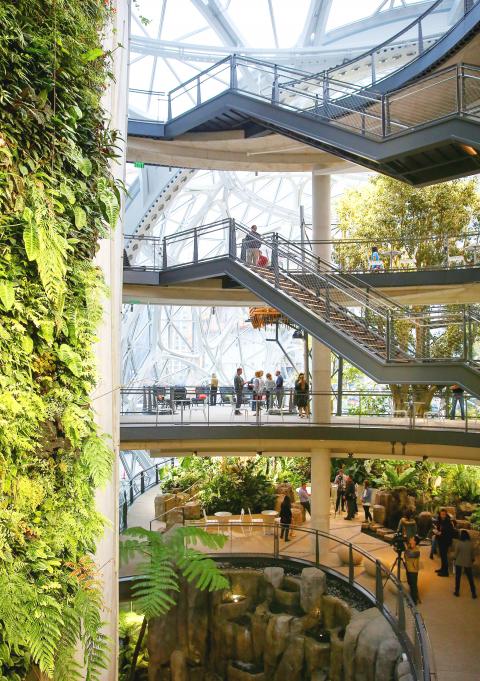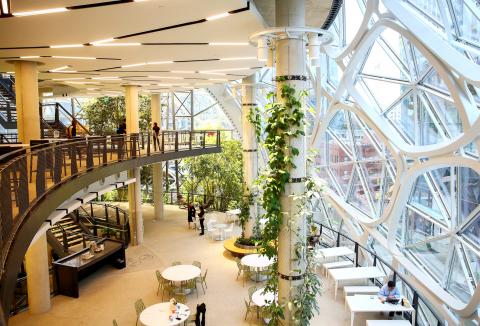The modern office is starting to look more like a Rainforest Cafe than a place of business. Amazon.com’s new Seattle headquarters has 40,000 plants. Down the coast, every other floor in Samsung’s two-and-a-half-year-old San Jose office space is a garden. Alibaba wants all employees in its Hangzhou workplace to be no more than a one-minute walk from an outdoor green space.
In a bid to keep workers happy, productive and, most important, in the office for as long as possible, companies have flocked to all sorts of design trends over the years. Last decade it was kegs and pingpong tables; now Mother Nature is in vogue.
The trend, called “biophilia,” is based on the idea that humans have an innate connection to nature.

Photo: Reuters
“We see it as returning to what our bodies and our brains need,” said Ryan Mullenix, a design partner at NBBJ, the architecture firm that worked on the new Amazon office. It’s like Paleo, for the office.
Because the wilderness is our natural habitat, biophilia advocates say, we feel more at ease there than in a sterile office. Research has found that offices outfitted to look more like the natural world lead to happier, healthier and more productive employees.
“When you look at a tree, you’re smarter,” explained Daniel Skiffington, a senior associate at NBBJ.

Photo: Reuters
Another way to look at it: If we have to be stuck inside all day without a minute to go out and get some fresh air, why not make our time in the sterile office as pleasant as possible?
Many people prefer daylight and plants to darkness and formica.
“Every day I wish for a small meteorite to crash through our building’s roof at night so we can get some sunlight in,” said Martin Bate, an analyst at BNSF Railway. Bate works in a converted factory with limited natural light.
“We’re certainly not vampires, so why don’t we have windows?”
Creating a nature-infused workplace isn’t as simple as buying a few thousand ferns. (Amazon hired a full-time horticulturist for its hyper-green space.) In its new office, North Carolina-based insurance brokerage Jackson Sumner & Associates installed View Dynamic Glass, a “smart” window that reduces glare and heat from the sunlight. No matter how bright or hot the sun shines, the company can keep the windows unobscured to let in natural light all day long.
Jackson Sumner also boasts a 26-foot-tall waterfall that puts ions into the air and uses lights with softer hues than a standard fluorescent bulb. Its pH-balanced water is filtered through copper pipes and stripped of any potentially harmful chemicals.
“Do you know where fluoride comes from? It’s a byproduct of the making of fertilizer,” said Wayne Sumner, the president and founder of Jackson Sumner. “We think that there are other ways to get fluoride.” (The U.S. Department of Health and Human Services recommends 0.7 milligram of fluoride per liter of drinking water to prevent tooth decay.)
Healthy buildings have been on the rise for at least a few years. In 2014 two former Goldman Sachs partners launched the Well Building Standard, a set of guidelines for designing buildings to make people happier, healthier and more productive. (Think LEED certification, but swap environmentalism for health and wellness.) Buildings that have clean air, an emphasis on walkability and healthy food — and meet a series of other criteria in seven categories—can achieve Well certification. The International Well Building Institute lists 545 office buildings around the world that qualify.
Many offices haven’t gone full Well but have borrowed elements of the healthy building lifestyle. View Dynamic Glass windows have been installed at more than 400 companies, including FedEx and Delta Air Lines. Plant walls aren’t an uncommon site in offices these days. Some companies have even adjusted the air circulation in their workspaces to offset “volatile organic compounds” in the air. Others have expressed interest in having an on-site aviary, said NBBJ’s Mullenix.
Like many office design trends, much of this is done in the name of productivity. Myriad studies point to the benefits of natural spaces. Plants make us more productive, one international study found. Another found that cortisol levels are higher in spaces with limited natural light. Elementary school students scored 20 percentage points higher on tests when they sat in naturally lit classrooms. And studies have linked stale office air to lower productivity.
Not all offices have to look like a jungle to have the intended effects. Aaptiv, a New York City-based technology company, has about 20 plants scattered across its one-floor open office.
“It makes it feel more laid-back and a little more peaceful,” said Jake Ludwig, a production coordinator in the audio department at Aaptiv. “It’s New York, it’s kind of gray. It’s nice to have a lot more green around.”

One of the biggest sore spots in Taiwan’s historical friendship with the US came in 1979 when US president Jimmy Carter broke off formal diplomatic relations with Taiwan’s Republic of China (ROC) government so that the US could establish relations with the People’s Republic of China (PRC). Taiwan’s derecognition came purely at China’s insistence, and the US took the deal. Retired American diplomat John Tkacik, who for almost decade surrounding that schism, from 1974 to 1982, worked in embassies in Taipei and Beijing and at the Taiwan Desk in Washington DC, recently argued in the Taipei Times that “President Carter’s derecognition

This year will go down in the history books. Taiwan faces enormous turmoil and uncertainty in the coming months. Which political parties are in a good position to handle big changes? All of the main parties are beset with challenges. Taking stock, this column examined the Taiwan People’s Party (TPP) (“Huang Kuo-chang’s choking the life out of the TPP,” May 28, page 12), the Democratic Progressive Party (DPP) (“Challenges amid choppy waters for the DPP,” June 14, page 12) and the Chinese Nationalist Party (KMT) (“KMT struggles to seize opportunities as ‘interesting times’ loom,” June 20, page 11). Times like these can

Dr. Y. Tony Yang, Associate Dean of Health Policy and Population Science at George Washington University, argued last week in a piece for the Taipei Times about former president Ma Ying-jeou (馬英九) leading a student delegation to the People’s Republic of China (PRC) that, “The real question is not whether Ma’s visit helps or hurts Taiwan — it is why Taiwan lacks a sophisticated, multi-track approach to one of the most complex geopolitical relationships in the world” (“Ma’s Visit, DPP’s Blind Spot,” June 18, page 8). Yang contends that the Democratic Progressive Party (DPP) has a blind spot: “By treating any

You can tell a lot about a generation from the contents of their cool box: nowadays the barbecue ice bucket is likely to be filled with hard seltzers, non-alcoholic beers and fluorescent BuzzBallz — a particular favorite among Gen Z. Two decades ago, it was WKD, Bacardi Breezers and the odd Smirnoff Ice bobbing in a puddle of melted ice. And while nostalgia may have brought back some alcopops, the new wave of ready-to-drink (RTD) options look and taste noticeably different. It is not just the drinks that have changed, but drinking habits too, driven in part by more health-conscious consumers and